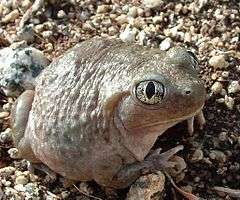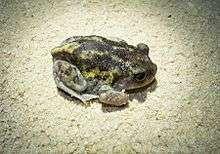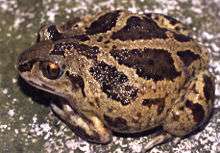American spadefoot toad
| American Spadefoot Toad | |
|---|---|
 | |
| Western Spadefoot Toad (Spea hammondii) | |
| Scientific classification | |
| Kingdom: | Animalia |
| Phylum: | Chordata |
| Class: | Amphibia |
| Order: | Anura |
| Suborder: | Mesobatrachia |
| Family: | Scaphiopodidae Cope, 1865 |
| Genera | |
| | |
| Distribution of Scaphiopodidae (in black) | |

The Scaphiopodidae are a family of threatened american spadefoot toads native to southern Canada, southern United States, and extend to southern Mexico. The Scaphiopodidae are a small family, comprising only seven different species.
The American spadefoot toads are of typical shape to most fossorial (or burrowing) frogs. They are round, with short legs and protruding eyes. As suggested by their name, these frogs have hard, keratinous protrusions present on their feet, which help them to dig. Like most fossorial frogs, they will dig backwards into the ground.[1]
The American spadefoot toads are terrestrial when not under ground. They are dully colored, usually a grey or dull green or brown. This is to aid in camouflage in their arid habitats.
Taxonomy
This family was previously included in the European spadefoot toad family, but has been split into two taxa. The Pelobatidae include the Pelobates genus, and Scaphiopodidae the rest.[2]
- Southern spadefoot toads, Scaphiopus (Holbrook, 1836)
- Western spadefoot toads, Spea (Cope, 1866)
Spadefoot toads are generally found in arid climates, where they spend the majority of their lives underground, generally beneath perennial ponds, creek beds, or other moisture-retaining areas. During years of sufficient rainfall, the toads surface to breed and lay eggs.
Appearance
Similar to other burrowing frogs, the American Spadefoot Toads are about 2-3 inches in length with round and stocky bodies and eyes that bulge from their heads. The name “Spadefoot” is derived from the keratinous bone in its hind legs that allow it to burrow within dirt. The skin of the toad is grey or brown in appearance and smooth to the touch.
Location and Environment
The seven species of Scaphiopodidae are found in different locations across North America. The Eastern Spadefoot is the only species found east of the Mississippi River, ranging from New England to southern Florida. The Great Basin Spadefoot and the Plains Spadefoot are both found in western Canada and the northwestern U.S. but the Plains Spadefoot has also spread into Texas and northern Mexico. The Couch’s Spadefoot, Hurter’s Spadefoot and New Mexico Spadefoot are all spread across the southern and southwestern U.S. with the Couch’s and Hurter’s also reaching into Mexico. The Western Spadefoot is the only species found in California, mainly southern parts of the state and extending into Mexico as well.[3]
The toads are believed to have moved into North America from South American Countries due to changing climate. They most likely moved into the U.S. as a single species, but split up as they spread across the continent and adapted to their new surroundings. The toads prefer marsh-like environments, but only enter the water to breed. They stay buried in the soil for most of the year as a mechanism to deal with changing weather.[4]
Diet
The American Spadefoot Toad has a unique diet. The adult’s diet and the tadpole’s diet vary. The adults diet consists of invertebrates.[5] They eat flies, crickets, caterpillars, moths, spiders, centipedes, millipedes, earthworms and snails.[6] The tadpole’s diet is related to its surroundings and food supply. When they are first born, they eat microscopic plants called plankton.[6] After a few days they become carnivorous and eat meat.[6] Tadpoles sometimes resort to cannibalism to survive. After multiple experiments,Paul Székely, Marian Tudor, and Dan Cogalniceanu concluded that tadpole development is influenced by hydroperiod, or the period in which an area is full of water.[7] Since American Spadefoot Toads breed in shallow waters, they are under “constant stress from drying waters, increasing temperatures, reduced food densities, and crowding”.[5] Since they are under an ample amount of stress,the tadpoles eat other tadpoles.[5] When they resort to cannibalism, begin to morph. They “develop larger heads, sharp beaks, stronger jaw muscles, and shortened intestine”.[5] Researchers have concluded that this is an adaptive trait because it accelerates the rate of growth of the tadpoles by allowing for an increased calorie intake.[5]
Conservation Efforts
The eastern Spadefoot entered the endangered list of Pennsylvania in 2005[8] (though also endangered in: Ohio, Connecticut, and Rhode Island[9]), when living populations were only found in two of their known locations. Which is odd because the American Spadefoot tadpole has the highest metamorphosis rates in any amphibian. Though one possibility for their lacking of population size could be that, “the pools often dry up before the tadpoles get to complete metamorphosis”(Naish, 2015[10]); though there are countless others.
So far conservation efforts have made effect in the prevention of the species habitat loss. In 2012 a couple learned that thirty two acres of a property they planned to subdivide and break ground on could potentially be Spadefoot habitat. So as per a species action plan put forth by Berks county conservancy and its partners, the couple would now need to seek state approval and, “hire someone familiar with the Eastern Spadefoot Toad to survey the tract for signs of its habitat”(Cress, 2012[11]).
As per conservation efforts, the awareness of citizens to the endangerment of Spadefoot toads in their regions has been a success. Though more effort is still needed to ensure the future of the Eastern Spadefoot toad.
Species of Scaphiopodidae
| Name | Biological Name | Description | Images |
|---|---|---|---|
| Couch's Spadefoot Toad | Scaphiopus couchii | The Couch's Spadefoot Toads are found in the South Western regions of the United States and some regions of Mexico. The Couch's Spadefoot Toads stay buried in the soil for 8–10 months a year and eat enough in one meal to last them a whole year. Couch's Spadefoot Toads' tadpoles transform into frogs in 7–8 days.[12] |  |
| Eastern Spadefoot Toad | Scaphiopus holbrookii | The Eastern Spadefoot Toads are found all along the eastern coast of United States. They are found from Southern New England to Florida. They are mostly found in areas with marshes and mixed hardwood swamps. The Eastern Spadefoot Toads can grow up to 3 inches long.[12] |  |
| Great Basin Spadefoot Toad | Spea intermontana | The Great Basin Spadefoot Toads can be found in the area spanning from south-central British Columbia, Canada to north western states of the United States of America such as Wyoming, Oregon and even California. Most of the Great Basin Spadefoot Toads are nocturnal and their diet includes of invertebrates such as ants.[12] | |
| Hurter's Spadefoot Toad | Scaphiopus hurterii | The Hurter's Spadefoot Toads are found in the southern states of the United States of America, such as Texas, Arkansas, Oklahoma and Louisiana. These toads were once thought to be a subspecies of the Eastern Spadefoot Toad.[12] | |
| New Mexico Spadefoot Toad | Spea multiplicata | The New Mexico Spadefoot Toads can be located in Mexico and some states in the south west region of the United States, such as Arizona, New Mexico and Nevada, as well as states like Utah and Colorado. The New Mexico Spadefoot Toads can grow up to 2.5 inches in length[12] | |
| Plains Spadefoot Toad | Spea bombifrons | The Plains Spadefoot Toads are located in southern Alberta, Canada, central states of the United States and northern parts of Mexico. They can grow up to 2 inches in length. They can be found in the areas with sand or gravel in soils near temporary bodies of water.[12] | |
| Western Spadefoot Toad | Spea hammondii | The Western Spadefoot Toads can mainly be found only in California and Baja California, Mexico. Unlike other toads, the Western Spadefoot Toads only enter water to breed.[12] |  |
References
- ↑ "Scaphiopodidae (Cope, 1865) American Spadefoot Toads". Archived from the original on 2006-08-30. Retrieved 2006-05-12.
- ↑ "Amphibian Species of the World - Pelobatidae Bonaparte, 1850". Archived from the original on 15 April 2006. Retrieved 2006-05-12.
- ↑ Greenberg, Cathryn H.; Tanner, George W. (2005-03-01). "Spatial and temporal ecology of eastern spadefoot toads on a florida landscape". Herpetologica. 61 (1): 20–28. doi:10.1655/04-32. ISSN 0018-0831.
- ↑ Bragg, Arthur N. (1945-01-01). "The Spadefoot Toads in Oklahoma with a Summary of Our Knowledge of the Group. II". The American Naturalist. 79 (780): 52–72. doi:10.1086/281236. JSTOR 2457924.
- 1 2 3 4 5 "What do Spadefoot toads eat?What do animals eat? - Find out here.". What do animals eat? - Find out here. Retrieved 2015-10-29.
- 1 2 3 "DEEP: Eastern Spadefoot Toad Fact Sheet". www.ct.gov. Retrieved 2015-10-29.
- ↑ "EBSCO Publishing Service Selection Page". eds.b.ebscohost.com. Retrieved 2015-10-29.
- ↑ Wayne, L. "Eastern spadefoot toad on endangered list". Retrieved 29 Oct 2015.
- ↑ "Species Action plan: Eastern Spadefoot" (PDF). Pennsylvania Fish and boat Commission. Retrieved 29 Oct 2015. Check date values in:
|date=(help) - ↑ Naish, D. "North American spadefoot toads and their incredible fast-metamorphosing, polymorphic tadpoles". Scientific American. Retrieved 29 Oct 2015.
- ↑ Cress, J. "Toad puts wrench in South Middleton Township subdivision plan". Retrieved 29 Oct 2015.
- 1 2 3 4 5 6 7 "Scaphiopodidae - American spadefoot toads | Wildlife Journal Junior". www.nhptv.org. Retrieved 2015-10-29.
External links
![]() Data related to Scaphiopodidae at Wikispecies
Data related to Scaphiopodidae at Wikispecies
![]() Media related to Scaphiopodidae at Wikimedia Commons
Media related to Scaphiopodidae at Wikimedia Commons
- Scaphiopodidae at Tree of Life
- American spadefoot toad at the Encyclopedia of Life
